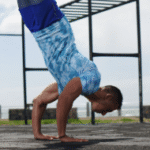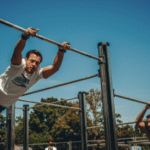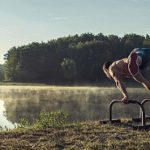Bulgarian Split Squats: Leg Day Just Got Harder (and More Effective)
The Bulgarian split squat, often called the “king of unilateral leg exercises,” is a challenging yet incredibly effective movement for building lower body strength, muscle, and balance. It takes the traditional squat and adds a unique twist – literally – by elevating your rear foot. This seemingly simple modification creates a whole new level of intensity and focuses the workload on one leg at a time.
Why Bulgarian Split Squats Reign Supreme:
Unilateral Strength: Working one leg at a time helps identify and address muscle imbalances, leading to more balanced strength and stability.
Increased Muscle Activation: Bulgarian split squats target your quads, glutes, hamstrings, and calves with laser focus, leading to greater muscle growth and definition.
Enhanced Balance and Stability: Balancing on one leg challenges your stability and coordination, improving your overall athleticism and reducing the risk of falls.
Improved Mobility: The exercise requires a good range of motion in your hips and ankles, promoting flexibility and mobility.
Versatile Exercise: Can be performed with bodyweight or added resistance (dumbbells, kettlebells, barbells).
Functional Strength: Mimics single-leg movements used in everyday activities and sports, making you stronger and more agile.
Mastering the Bulgarian Split Squat:
Find Your Setup:
Bench or Platform: You’ll need a bench, box, or sturdy platform that’s roughly knee-high.
Stance: Stand facing away from the bench, about a stride’s length away.
Elevate Your Rear Foot:
Placement: Rest the top of your rear foot on the bench, laces down.
Front Foot: Position your front foot far enough forward to allow for a comfortable 90-degree bend in both knees.
Lowering Phase:
Controlled Descent: Keeping your torso upright and core engaged, slowly lower your back knee towards the ground.
Front Knee Tracking: Ensure your front knee tracks over your ankle, not extending beyond your toes.
Pushing Phase:
Drive Up: Push through your front heel to return to the starting position, extending your hips and front knee.
Full Extension: Stand tall at the top of the movement.
Common Mistakes to Avoid:
Front Knee Cave-In: Push your front knee outward to prevent it from collapsing inward.
Leaning Forward: Keep your torso upright and avoid excessive forward lean.
Short Stride: Take a long enough stride to allow for a comfortable 90-degree bend in both knees.
Unstable Rear Foot: Ensure your rear foot is securely placed on the bench.
Bulgarian Split Squat Variations and Progressions:
Bodyweight: Start with bodyweight to master the form.
Dumbbells: Hold dumbbells in each hand for added resistance.
Barbell: Challenge yourself with a barbell across your upper back (requires good balance and core strength).
Front Foot Elevated: Place your front foot on a slight elevation (like a weight plate) to increase the range of motion and challenge your ankle mobility.
Deficit Bulgarian Split Squat: Stand on a slightly elevated platform to increase the range of motion and difficulty.
Tips for Success:
Start Light: Begin with bodyweight and gradually progress to heavier weights or more challenging variations.
Prioritize Form: Focus on maintaining proper form throughout the entire movement.
Warm-Up: Prepare your legs and hips with dynamic stretches and light cardio before performing Bulgarian split squats.
Listen to Your Body: Rest when needed and address any pain or discomfort.
Consistency is Key: Incorporate Bulgarian split squats into your leg routine regularly to see consistent progress.
Bonus Resources:
YouTube Tutorials: Search for “Bulgarian split squat tutorials” or “how to do Bulgarian split squats with proper form” on YouTube.
Strength Training Guides: Consult strength training guides or books for detailed information on Bulgarian split squat variations and progressions.
Certified Trainers: Consider working with a certified strength and conditioning coach for personalized guidance and feedback.
By mastering the Bulgarian split squat, you’ll unlock a new level of lower body strength, muscle growth, and athleticism. So, embrace the challenge and elevate your leg day game!

Bulgarian Split Squats: Leg Day Just Got Harder
Route
Calisthenics Gym Houston Functional Bodyweight Training
Secondary phone: (346) 483-3195
Email: info@calisthenicsclubhouston.com
URL: https://calisthenicsclubhouston.com/
Monday 6:00 AM - 7:00 PM Tuesday 6:00 AM - 7:00 PM Open now Wednesday 6:00 AM - 7:00 PM Thursday 6:00 AM - 7:00 PM Friday 12:00 PM - 6:30 PM Saturday 9:45 AM - 12:00 PM Sunday 3:00 PM - 5:00 PM





